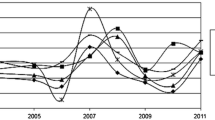Abstract
We construct a structural macroeconometric model for member states of the West African Economic and Monetary Union (UEMOA). Fitting this model to annual and quarterly time-series data allows us to identify the channels through which macroeconomic innovations in one country impact on other countries in the union. We also discover the extent of heterogeneity across the member states in terms of the degree of similarity of macroeconomic transmission mechanisms. This is one important element in measuring the costs of union membership for each country.


Similar content being viewed by others
Notes
There are no explicit aggregate supply relationships in the model. However the model is consistent with the existence of country-specific productivity shocks that impact on the country’s output and on all other variables in the system through the relations embedded in the model.
The justification for the use of a common interest rate in the countries’ IS relations is provided below.
Indeed, one finds empirically that, when the BCEAO rediscount rate is included in a structural VAR model, it exhibits no significant relationship with any other macroeconomic variable.
The hypothesis is rejected at the 5% level in every case except the IS relationship for Senegal, where the test is significant at the 10% level.
In Togo, the long-run real exchange rate coefficient has the opposite sign. One limitation of our import price data is that we cannot distinguish between the prices of imports of consumer goods from those of capital and intermediate goods. If the latter are a large component of total imports then an increase in e t reflects an increase in production costs, relative to aggregate prices. Such an increase might depress investment demand, and this might explain the unexpected real exchange rate effect in Togo.
One can think of the exogeneity assumption as placing the interest rate variable first in the vector of variables (so that the interest rate influences the variables that follow it contemporaneously, but is not influenced by them). In this case, the GIR is the same as the Orthogonalised Impulse Responses, associated with Sims (1980), that are more typically reported.
References
Adam C (1992) On the dynamic specification of money demand in Kenya. J Afr Econ 1:233–270
Easterly W, Levine R (1997) Africa’s growth tragedy: policies and ethnic divisions. Q J Econ 112:1203–1250
Fielding D, Bleaney M (2000) Monetary discipline and inflation in developing countries: the role of the exchange rate regime. Oxf Econ Pap 52:521–538
Fielding D, Shields K (2001) Modelling macroeconomic shocks in the CFA Franc zone. J Dev Econ 66:199–223
Fielding D, Shields K (2005) Economic integration in West Africa: does the CFA make a difference? Economica 72:683–704
Fielding D, Lee K, Shields K (2004) The characteristics of macroeconomic shocks in the CFA Franc zone. J Afr Econ 13:488–517
Garratt A, Lee K, Pesaran MH, Shin Y (2003) A long run structural macroeconometric model of the UK. Econ J 113:412–455
Hoffmaister AW, Roldós JE, Wickham P (1998) Macroeconomic fluctuations in Sub-Saharan Africa. IMF Staff Pap 45:132–160
Koop G, Pesaran MH, Potter SM (1996) Impulse response analysis in nonlinear multivariate models. J Econom 74:119–147
Lee KC, Pesaran MH (1993) Persistence profiles and business cycle fluctuations in a disaggregated model of UK output growth. Ricerche Economiche 47:293–322
Lisman JHC, Sandee J (1964) Derivation of quarterly figures from annual data. Appl Stat 13(2):87–90
Pesaran MH, Shin Y, Smith RJ (2001) Bounds testing approaches to the analysis of level relationships. J Appl Econom, Special Issue in Honour of J.D. Sargan on the theme “Studies in Empirical Macroeconometrics”, Hendry DF, Pesaran MH (eds) 16:289–326
Stasavage D (1997) The CFA Franc zone and fiscal discipline. J Afr Econ 6:132–167
World Bank (2003) Millennium development goals. http://www.developmentgoals.org/Data.htm
Author information
Authors and Affiliations
Corresponding author
Data appendix
Data appendix
Data is obtained at quarterly frequency from the IMF International Financial Statistics and individual Central Bank sources. Variable definitions are as follows:
- R t :
-
Annualised French government bond yield [IFS],
- S t :
-
CFA Franc—French Franc exchange rate [IFS],
- M t :
-
Total money base, including M0 and demand deposits in domestic banks, across all the countries in CFA zone [Central Bank balance sheets],
- P it :
-
Consumer price index, in CFA Francs [IFS],
- \(Y_{t}^{\ast }\) :
-
World trade, measured by total export volumes in billions of $US [IFS].
For these variables, the corresponding annual series are obtained through averaging. Data obtained at the annual frequency include:
- Y it :
-
Real annual GDP in 1990 CFA Francs [World Bank World Development Indicators],
- P x it :
-
Export price index, weighted average of prices, in CFA Francs, of all commodities exported by country i,
- \(P_{it}^{z^{\ast }}\) :
-
Import price index, weighted average of prices, in CFA Francs, of all commodities imported by country i.
Corresponding quarterly series for outputs were obtained using quarterly electricity consumption figures from the BCEAO Notes d’Information et Statistiques, as described in the text. Quarterly import price and export price indices were derived using the interpolation procedures described in Lisman and Sandee (1964). The import price index measured in French Francs, is given by \(P_{it}^{z\ast }= P_{it}^{z}/S_{t}\).
Rights and permissions
About this article
Cite this article
Fielding, D., Lee, K. & Shields, K. Does one size fit all? Modelling macroeconomic linkages in the West African Economic and Monetary Union. Econ Change Restruct 45, 45–70 (2012). https://doi.org/10.1007/s10644-011-9109-9
Received:
Accepted:
Published:
Issue Date:
DOI: https://doi.org/10.1007/s10644-011-9109-9




